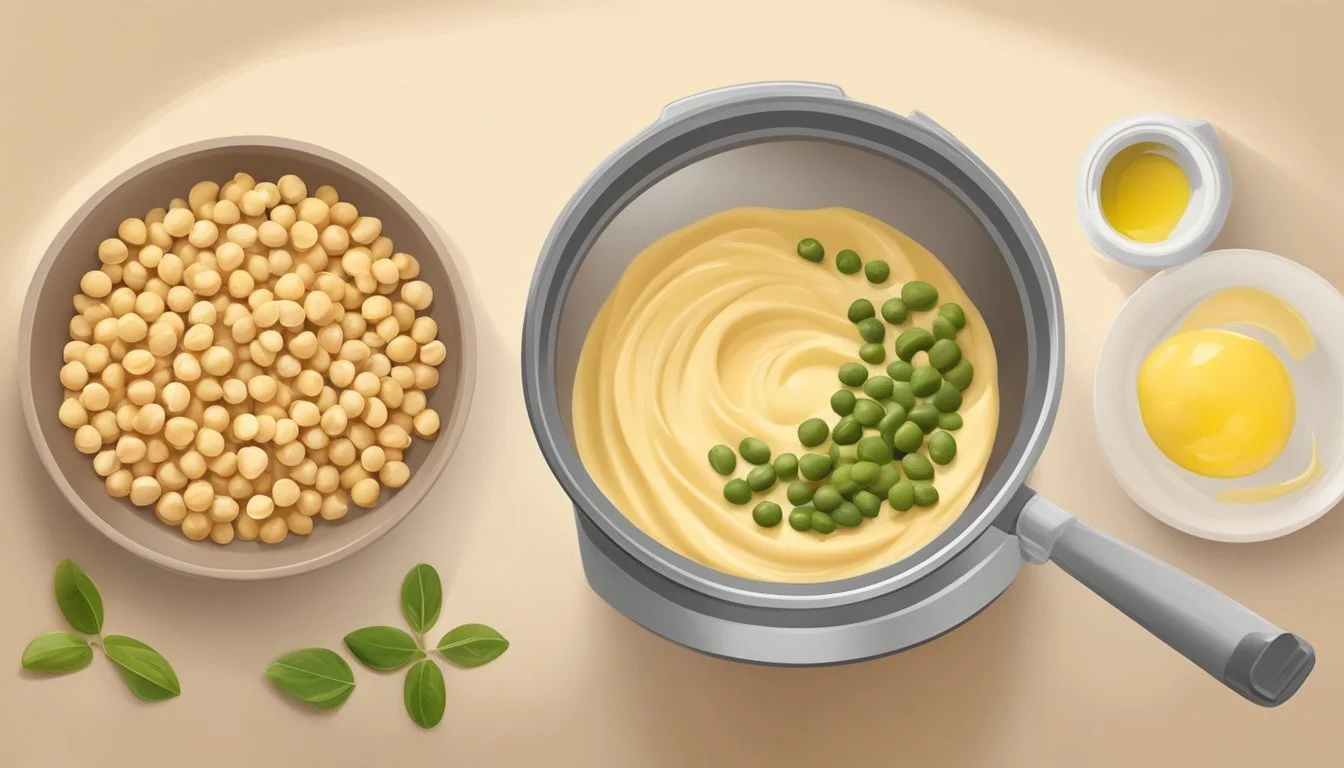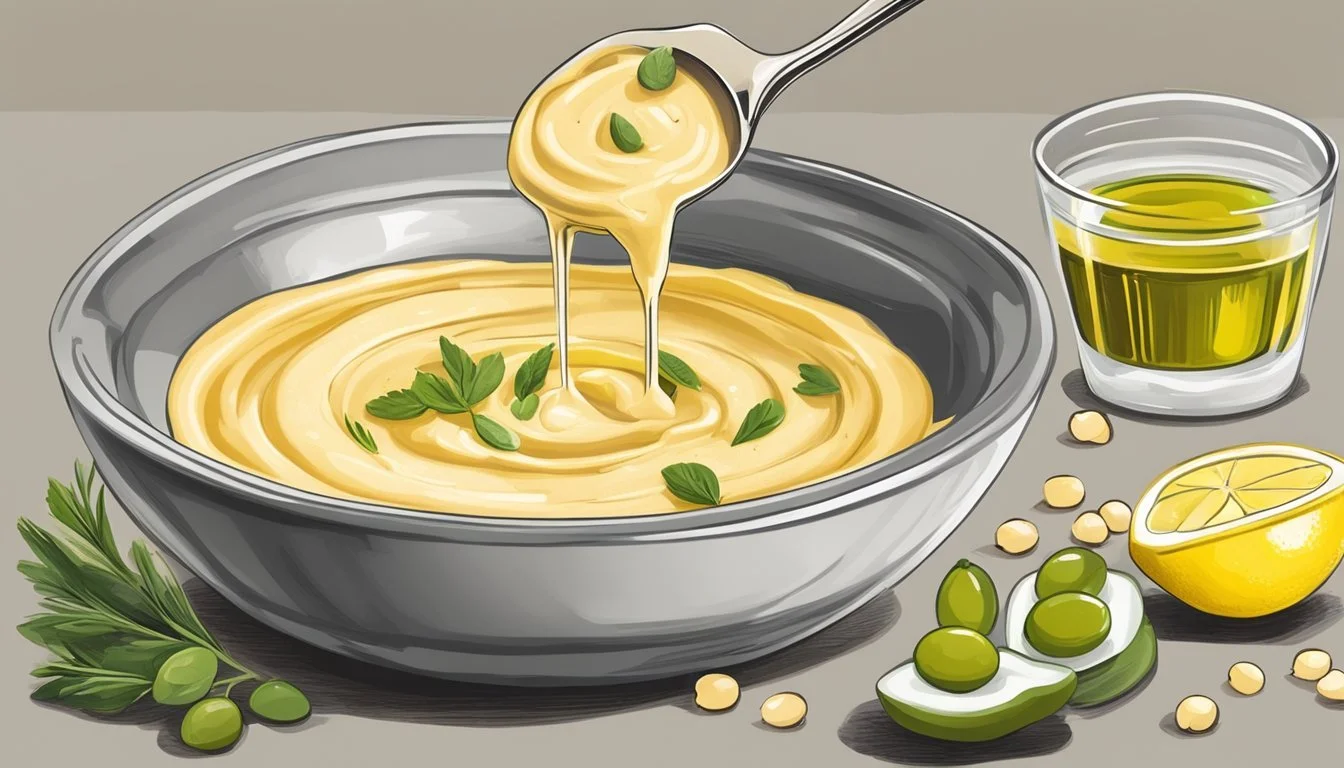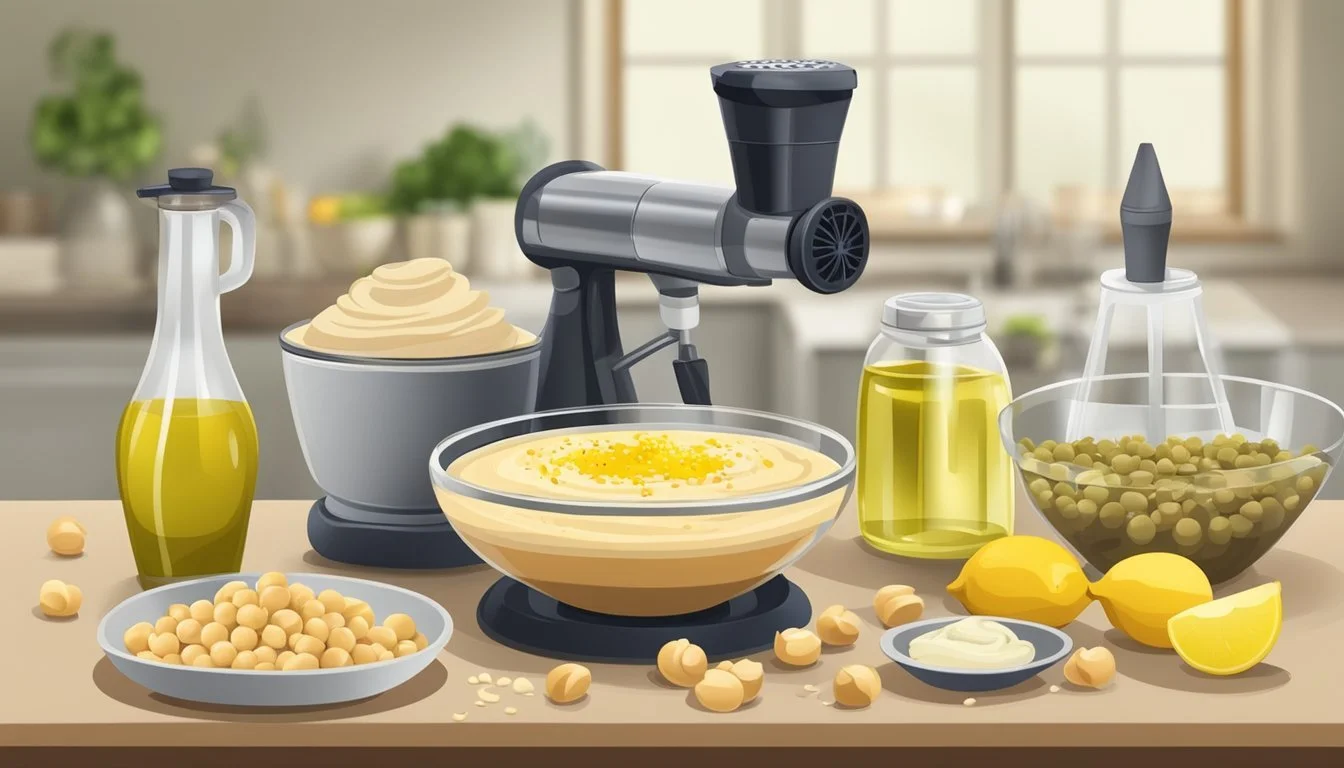Fixing Watery Hummus
Expert Tips for Achieving the Perfect Consistency
Hummus, a widely enjoyed dip and spread, has become a staple in many kitchens due to its rich flavor and versatile use. Originating from Middle Eastern cuisine, this creamy blend primarily made from chickpeas, tahini, lemon juice, and garlic can be used in various dishes or served as a stand-alone appetizer. The texture and consistency of hummus are crucial to its enjoyment, with a perfectly thick and smooth consistency being the mark of well-made hummus.
When hummus turns out too watery, it can be disappointing, affecting both the flavor and its ability to cling to foods like bread and vegetables. Achieving the right thickness requires a balance of ingredients and technique. From incorporating more chickpeas to adjusting the tahini quantity, several methods can restore the desired consistency without compromising the taste. The thickening process not only involves adding components but also controlling factors like blending time and the addition of liquids—which can prevent the hummus from becoming too runny in the first place.
Thickening watery hummus is an art that does not require elaborate tools or ingredients. With a few simple adjustments, anyone can elevate the texture of their homemade hummus. Whether one prefers a subtle tweak by adding ground nuts or beans, or opts for a more traditional approach by adjusting the main components, there are multiple ways to ensure that hummus achieves the perfect spreadability and mouthfeel that makes it such a beloved dish across cuisines.
Understanding Hummus Consistency
Achieving the perfect consistency in hummus hinges on the precise balance of its ingredients and the understanding of factors that contribute to its texture.
Role of Ingredients and Ratios
In traditional hummus recipes, the primary ingredients are chickpeas, tahini (sesame paste), olive oil, lemon juice, and garlic. The consistency of hummus is largely dependent on the correct ratio of these components:
Chickpeas: The foundation of hummus, they should be cooked until soft and blended smoothly.
Tahini: Affects the creaminess and can thicken the mixture when used in ample quantities.
Olive Oil: Adds silkiness and can be adjusted to fine-tune the dip's density.
Lemon Juice/Garlic: While they contribute to the flavor profile, adding too much can increase the liquid content and result in a runnier texture.
Adjusting any of these elements can significantly alter the texture, making it either too thick or too runny.
Common Causes of Watery Hummus
Several factors can lead to a watery hummus consistency:
Excess Liquid: Adding too much water during the blending process can dilute the mixture. Use water sparingly, only to adjust the thickness if necessary.
Overcooked Chickpeas: Extremely soft chickpeas can create a mushy texture. While they should be cooked thoroughly, they must retain some structure.
Tahini Quality: The consistency of tahini can vary. A thinner tahini will contribute to a looser hummus, while a thicker one will make for a denser spread.
Chickpea Skin: The skin of chickpeas can contribute to a chunkier texture. For smooth hummus, one may consider removing the skins.
Improper Ratios: Deviating from the standard proportions of ingredients can unbalance the texture. Maintaining tried-and-true ratios is key for ideal consistency.
Water Content of Ingredients: Fresh ingredients like lemon juice or garlic can introduce additional water into the hummus, affecting its thickness.
Monitoring these aspects during preparation can prevent a runny outcome and help maintain the desired consistency of the hummus.
Thickening Techniques for Hummus
Achieving the perfect texture for hummus can be easily managed by adjusting the base ingredients, utilizing thickeners and additives, or trying some non-traditional fixes.
Adjusting the Base Ingredients
To thicken hummus, one should first consider altering the proportion of the base ingredients. Chickpeas serve as the primary thickening agent. Adding more chickpeas will naturally enhance the texture. Furthermore, incorporating extra tahini can also lend creaminess and density to an overly runny hummus. Heed should be taken not to alter the fundamental flavor of the dip, just improve its consistency.
Using Thickeners and Additives
Adding established thickeners is a direct approach to modify the consistency of hummus:
Olive oil: Drizzle sparingly to emulsify and thicken the blend.
Protein-rich ingredients: Consider adding a spoonful of yogurt for a richer, thicker product.
Dessicated powders: In small quantities, mashed potato flakes or even a pulse flour made from dried chickpeas could be used to achieve the desired thickness.
Non-Traditional Fixes
One may also opt for less conventional methods to enrich the texture of hummus:
Beans: White or black beans can supplement chickpeas to thicken hummus without significantly altering the taste, if used in a proper ratio.
Nuts: Ground nuts like almonds or pistachios can not only thicken hummus but also add a unique flavor profile.
The use of these ingredients should be carefully balanced to maintain a harmonious flavor while achieving the perfect hummus texture.
Refining Flavor and Texture
Achieving the perfect balance of spices and creating a velvety texture are crucial in transforming runny hummus into a sumptuous spread. By carefully adjusting each component, one can enhance the overall flavor and consistency of their hummus.
Balancing Spices and Seasonings
In a quest for the ideal flavor profile, the addition of spices and seasonings must be thoughtful:
Salt and Pepper: These fundamental seasonings should be added gradually, with regular tasting to avoid overpowering the hummus.
Cumin: A subtle amount of cumin can introduce a warm, earthy undertone. Start with a modest pinch and adjust according to taste.
Lemon: The right squeeze of lemon not only brings zest but also can balance any excess richness.
Garlic: Fresh minced garlic can add a pungent depth; one to two cloves are usually sufficient for a batch.
One should always mix these spices and seasonings with precision to avoid under or over-seasoning.
Enhancing Creaminess
To elevate a watery hummus to that silky consistency, one should consider the following techniques:
Sesame Paste (Tahini): Gradually blend in extra tahini to enrich the creaminess while contributing a nutty flavor.
Olive Oil: A slow drizzle of high-quality olive oil while blending can smooth out the texture and add a luxurious mouthfeel.
The care with which one incorporates these ingredients will directly affect the creaminess and palatability of the final product.
Serving and Pairing Hummus
Hummus is versatile in its applications; it can elevate a simple snack to a flavorful and hearty option. When served and paired correctly, hummus not only serves as a dip but also functions as a nutritious spread, enhancing a variety of dishes.
Ideal Dippers and Vegetables
Pita Chips and Bread: A classic pairing, pita chips offer a satisfying crunch and are sturdy enough to scoop generous amounts of hummus.
Naan: This soft, pillowy bread can be used as a scoop or torn into pieces for dipping, adding an Indian flair to the snack.
Crudités: Fresh vegetables like carrot sticks, cucumber slices, and bell pepper strips provide a refreshing and healthy companion to the rich flavors of hummus.
Cherry Tomatoes: Bite-sized and juicy, cherry tomatoes complement the creaminess of hummus when served together.
Creative Spread Uses
Sandwiches: Hummus can be spread on bread, adding depth and moisture. It’s a healthier alternative to mayonnaise or butter.
Wraps: A layer of hummus in a wrap with vegetables and protein turns an average dish into a more complete meal.
Pizzas: Spreading hummus on a pizza base before adding toppings introduces a unique twist to traditional flavors.
Grilled Veggies: Before grilling, coat vegetables like zucchini or eggplant in hummus for an enhanced taste and charred texture.
Preservation and Storage Tips
When it comes to hummus preservation, maintaining its freshness and nutrition is essential. Proper storage techniques prevent spoilage and preserve the quality of the dip.
Refrigerating Homemade Hummus
Storing homemade hummus in the refrigerator effectively maintains its freshness for 3 to 4 days. It's crucial to transfer the hummus to an airtight container before refrigerating to prevent exposure to air, which can affect both flavor and texture. Homemade hummus lacks the preservatives found in store-bought varieties, so it's essential to consume it within this time frame to enjoy its optimal taste and nutrition.
Freezing and Thawing Practices
For longer storage, homemade hummus can be frozen for up to 6 months. To freeze, one should portion the hummus into suitable airtight containers or vacuum-sealed bags. This prevents freezer burn and taste alteration. When ready to use, thaw it overnight in the refrigerator to preserve the consistency. Rapid thawing methods are not recommended as they can compromise the structure of the hummus, leading to a separation of ingredients.
Health Benefits and Dietary Considerations
Hummus is a nutrient-dense spread that can complement various dietary needs. It's notable for its protein content and compatibility with vegan and vegetarian diets.
Nutritional Information
Hummus is rich in several essential nutrients, making it a healthy addition to one's diet. Here is a breakdown of its main nutritional components:
Protein: A valuable source of plant-based protein, important for muscle repair and growth.
Vitamins and Minerals: It contains vitamins such as vitamin C and minerals like iron and calcium.
Fiber: Offers dietary fiber which aids in digestion and helps maintain a healthy gut.
Healthy Fats: Includes heart-healthy fats from ingredients like olive oil, which can help to lower the risk of heart disease.
Nutrition per 100 grams of hummus typically includes:
Nutrient Amount Calories 166 kcal Protein 7.9 g Fat 9.6 g Carbohydrates 14.3 g Fiber 6.0 g Sugars 0.3 g
Incorporating Hummus into Various Diets
Hummus is a versatile food that can be included in many types of diets:
Vegan and Vegetarian: As a plant-based protein source, hummus is ideal for individuals following vegan or vegetarian diets.
Gluten-Free: Naturally gluten-free, it is suitable for those with gluten intolerances or celiac disease, provided that no gluten-containing additives are included in the hummus or the accompanying food.
Balanced Diet: Its nutrient profile complements a balanced diet, providing energy, protein, and healthy fats.
Consumers should be mindful of portion sizes and added ingredients that could change the nutritional value of hummus.
Troubleshooting Common Issues
When facing issues with runny hummus, understanding the appropriate thickening techniques is crucial. Adjusting the ingredients and preparation method can reinstate the desired consistency.
Dealing with Runny Hummus
Runny hummus often results from an imbalance between solid ingredients and liquid content during preparation. Here are specific steps to correct this issue:
Add Chickpeas: Incorporating more cooked chickpeas will naturally thicken the hummus while maintaining the authentic flavor.
Introduce More Tahini: A spoonful of tahini can fortify the consistency, but one must be cautious of the cost if using store-bought varieties.
Adjust Liquid: When adding ingredients like lemon juice or olive oil, do so gradually. Hummus' consistency can dramatically change with just a small amount of additional liquid.
Use a Food Processor Sparingly: Overprocessing can introduce excess air and heat, potentially contributing to a runnier texture.
Consider Flour: In emergencies, flour mixed with water can serve as a thickening paste, but this may alter the original texture and taste of the hummus.
It is essential to add ingredients slowly and blend cautiously in the food processor to avoid over-thinning the hummus.
Hummus Variations and Innovations
Hummus serves as a versatile canvas for a myriad of flavors, allowing both traditional Mediterranean ingredients and bold, experimental combinations to shine through its creamy texture.
Mediterranean Influences
The roots of hummus in Mediterranean cuisine have sprouted numerous variations that incorporate classic regional ingredients for an authentic twist. Greek yogurt can be blended into hummus for a tangier, creamier texture, while parsley offers a bright, herbaceous lift. For a Greek-inspired version, chunks of feta cheese and kalamata olives provide briny, sharp notes that contrast the smooth base. A dash of tzatziki, with its cool cucumber and dill flavors, can transform a simple hummus into a refreshing delish dip that pairs perfectly with pita.
Moreover, the inclusion of tomato and cucumber not only adds a crisp, fresh dimension but also complements the rich taste of classic hummus, making it ideal for a Mediterranean-themed appetizer platter.
Fusion and Experimental Flavors
Beyond the shores of the Mediterranean, chefs and home cooks alike revel in the creation of fusion and experimental flavors using hummus as the foundation. The adaptability of hummus has seen it cross culinary borders, integrating spices and components from various cuisines. One might find a hummus enriched with bold Asian seasonings, such as wasabi or ginger, offering a surprising kick that challenges traditional palate expectations.
The culinary adventure doesn't stop there, as some innovations lead to the incorporation of unconventional ingredients like sun-dried tomatoes, roasted red peppers, or sweet caramelized onions, delivering a more complex profile that entices the adventurous eater.
By embracing both the time-honored Mediterranean staples and daring global infusions, hummus variations and innovations continue to push the boundaries of this beloved spread.
Making Hummus an Entertaining Highlight
When aiming to impress guests with an appetizing creation, hummus can be the star of the show. By utilizing fresh ingredients and layering flavors, one can craft delightful spreads that turn the humble dip into a festive culinary event.
Crafting a Hummus-Centered Appetizer
A successful hummus-centered appetizer starts with a perfectly thickened hummus as its base. The key is achieving a creamy and spreadable consistency that can hold up to the addition of various toppings. Here's how to present a vibrant appetizer:
The Base: Begin with a thick hummus spread on a platter.
The Toppings: Artistically arrange a variety of crisp veggies such as sliced cucumbers, colorful bell peppers, and cherry tomatoes.
The Garnish: Enhance the visual appeal and taste with a sprinkle of feta cheese, a handful of kalamata olives, and a dusting of sumac or paprika.
Finishing Touches: Drizzle with olive oil and scatter fresh parsley for a fresh, herbaceous note.
This appetizer not only caters to the eyes but also offers a range of textures and flavors that excite the palate.
Building a Greek Layer Dip
For those seeking a more substantial offering, a Greek layer dip elevates the basic hummus with an array of complementary flavors. Assemble it as follows:
The Foundation: Spread the thickened hummus in a clear dish to showcase the layers.
Creamy Layer: Add a layer of plain Greek yogurt to introduce a tangy twist.
Fresh Elements: A layer of diced cucumbers and halved grape tomatoes contributes juiciness and crunch.
Cheese and Herbs: Crumble feta cheese generously and sprinkle a mix of dill and fresh parsley for aromatic depth.
Olives: Scatter a layer of chopped olives for a salty, briny dimension.
Serving: Serve with pita chips or warm pita bread for dipping.
Each spoonful of the Greek layer dip ensures a harmonious blend of rich hummus, cool yogurt, salty feta, and fresh vegetables, making it an exemplary choice for any gathering.
Frequently Asked Questions (FAQs)
In the following FAQs, one will find specific techniques to perfect the consistency and taste of their hummus, as well as answers to common preparation and cooking questions.
Tips for Perfect Hummus Every Time
1. Tips for Consistency:
For thicker hummus, one may consider adding more canned chickpeas to achieve the desired consistency.
Incorporating toasted nuts such as walnuts or almonds can enhance the dip's thickness while adding a nutty flavor.
2. Tips for Flavor Enhancement:
Drizzle extra virgin olive oil on top to add richness.
Herbs such as mint, basil, or oregano can be sprinkled to infuse fresh notes.
A pinch of Aleppo pepper can introduce a subtle, fruity heat to the hummus.
Addressing Preparation and Cooking Queries
1. Preparation of Chickpeas:
If using canned chickpeas, rinse and drain them well to remove excess moisture that could contribute to watery hummus.
2. Cooking Considerations:
To avoid a runny texture, add water gradually during blending, monitoring the consistency closely.
Employing these suggestions will significantly improve one's hummus, turning it into a perfectly textured and flavorsome spread or dip.









